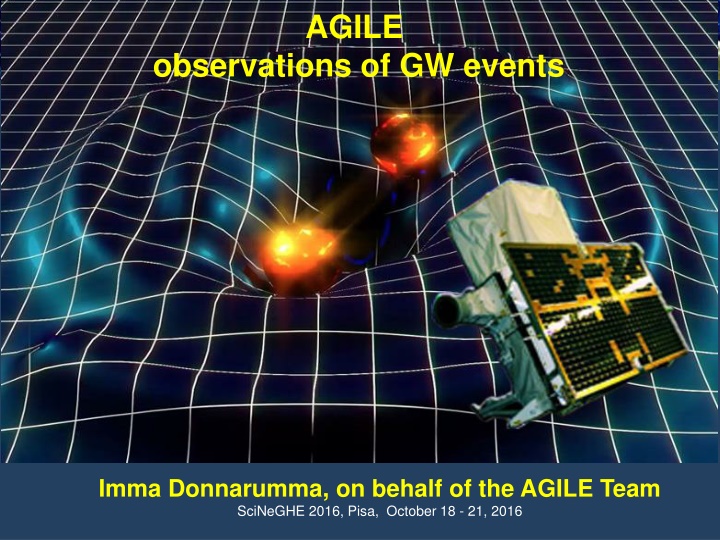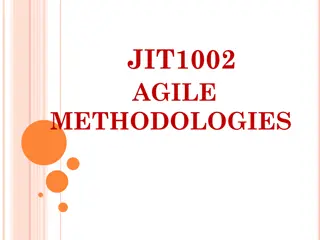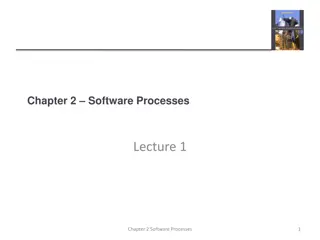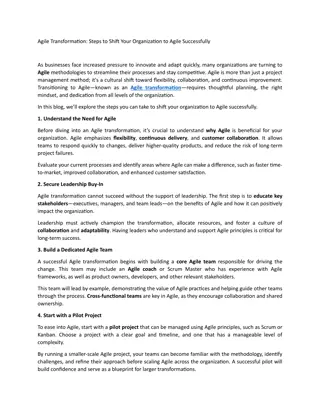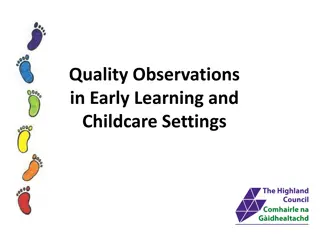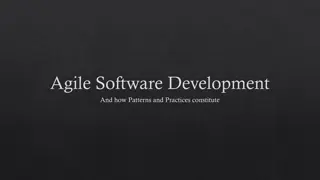Fascinating Insights into AGILE - Observations of GW Events
Delve into the AGILE team's groundbreaking observations of gravitational wave (GW) events, showcasing the unique capabilities of the AGILE satellite in gamma-ray detection, rapid response to transients, and potential identification of GW source counterparts. Discover the innovative technology and instrumental role AGILE plays in high-energy astrophysics and cosmic phenomena research.
Download Presentation

Please find below an Image/Link to download the presentation.
The content on the website is provided AS IS for your information and personal use only. It may not be sold, licensed, or shared on other websites without obtaining consent from the author.If you encounter any issues during the download, it is possible that the publisher has removed the file from their server.
You are allowed to download the files provided on this website for personal or commercial use, subject to the condition that they are used lawfully. All files are the property of their respective owners.
The content on the website is provided AS IS for your information and personal use only. It may not be sold, licensed, or shared on other websites without obtaining consent from the author.
E N D
Presentation Transcript
AGILE observations of GW events Imma Donnarumma, on behalf of the AGILE Team SciNeGHE 2016, Pisa, October 18 - 21, 2016
AGILE two "lives": pointing and spinning AGILE POINTING SPINNING time period Jul.07 Oct.09 Nov. 2009 - today variable (rotation ~ 0.8 /sec) attitude fixed sky coverage 1/5 ~ 70-80 % 1-day exposure ( 30 deg off-axis, @ 100 MeV) ~ 2 x 107 (cm2 sec) (0.5 - 1) x 107 (cm2 sec)
AGILE in spinning coverage of the gamma-ray sky, E > 100 MeV (8 March, 2016) 3
AGILEs life Gamma-ray detector and MCAL fully operational, ideal in the range 50 MeV 1 GeV, and active in: gamma-ray astrophysics terrestrial high-energy physics search of GW counterparts 4
AGILE has the shortest reaction time to bright gamma-ray transients Blazars (fast ATels) Galactic transients (recently Cyg X-3, Crab Nebula flare) excellent for GW source searches very large field of view (2.5 sr) 200 passes/day over more than 80% of the sky High probability of prompt event coverage 5
AGILE can play a crucial role in the search of GW source counterparts AGILE and GW150914 (and GW151226) Prospects for a first detection of prompt gamma-ray emission GW sources 6
AGILE in spinning: revolution including T0 of GW150914 Tavani et al. 2016 7
GW150914 T0 = 9:50:45 UT, 14 September, 2015 learned about the event on Feb. 11, 2016 (no MoU active yet) archival search
Central LIGO contour exposure scan: from T0 -300s to T0 +500s Mean exposure within 7o x 25o region (black) and 10o radius circular region (red) at about the LIGO contour center 100s exposure scan 65% of LIGO contour covered ~10-60s before T0 15
AGILE exposure 330 sec (+/- 50 sec) 2-sigma upper limit (E > 50 MeV) = 1.5 x 10-8 erg cm-2 s-1
AGILE and Fermi-LAT upper limits in the GRB090510 lightcurve (repositioned at z = 0.1, adapted from Fermi-LAT Collab., 2016) AGILE upper limit 250-350 sec after T0 Fermi-LAT UL > 4500 s after T0
AGILE-MCAL and Fermi-GBM exposure at the GW150914 prompt time 21
AGILE does not detect the Fermi-GBM transient at the GW150914 prompt time, best GBM position region at about 90 off-axis for AGILE GRID and MCAL limited exposure of MCAL AGILE 5-sigma MCAL upper limit FGBM = 2 x10-6 erg cm-2 (0.45 100 MeV), 2.5 times larger than GBM event extrapolation at 1 MeV FGBM = (2 1) x10-7 erg cm-2 (10 keV 1 MeV), photon index 1.4 22
AGILE-MCAL GRB090510 light curve GRB090510 light curve as detected by MCAL (4ms bin), Giuliani + 2010 ->15ms soft precursor at T=T0 - 0.55 s (Epeak < 0.7MeV)
precursor search (passes -13/+1, 95 minutes) -13 -12 -11 -10 -7 -9 -6 -8 -5 -4 -3 -2 -1 +1 25
GW 151226 27
Ready for the O2 Run New on-board configuration Enhanced configuration of Mcal triggers-> improved at sub-ms/ms timescales (short GRBs) SuperAGILE active 28
AGILE Data Center: recent upgrades (C. Pittori) New optimized automatic AGILE data processing to reduce latency in view of the next O2 GW Ligo-Virgo run. New MCAL and GRID QL pipelines active since Aug 3, 2016 Improved ASINet connection between MOC (Fucino) and SOC (ASDC), and reduced polling times for external connections Now: less than 25 min (on average) between the satellite data acquisition at Malindi Ground Station and the availability of first reconstructed gamma-ray event files (it was approx 2 hours before) a factor of 4-5 better than before) 29
AGILE GW on-line analysis @IASF-BO RT-PIPE Visibility check (RT) manual injection MoU GW analysis GCN notice RT- external alerts ALERT DB GRB analysis SPOT6 analysis LVC_PRELIMINARY: Provides the time, significance, and basic parameters about a GW detection candidate. No localization information. Sent with a latency of a minute or so. LVC_INITIAL: A rapid sky localization is available. Sent with a latency of a few minutes. LVC_UDPATE: A refined sky localization is availaable. Sent with a latency of hours or more. 1 2 3 3 0
? -8 10 Sensitivity (erg cm-2 s-1) SPI IBIS-PICsIT -9 10 COMPTEL -10 10 EGRET -11 10 HAWC CTA North Fermi-LAT VERITAS IBIS-ISGRI -12 10 e-ASTROGAM HiSCORE JEM-X MAGIC -13 10 CTA South LHAASO -14 10 -2 -1 102 103 104 105 106 107 108 109 10 10 10 1 10 10 Energy (MeV)
The e-ASTROGAM core science Processes at the heart of the extreme Universe: prospects for the Astronomy of the 2030s The origin and impact of high-energy particles on galaxy evolution, from cosmic-rays to antimatter Nucleosynthesis and the chemical enrichment of our Galaxy 33
